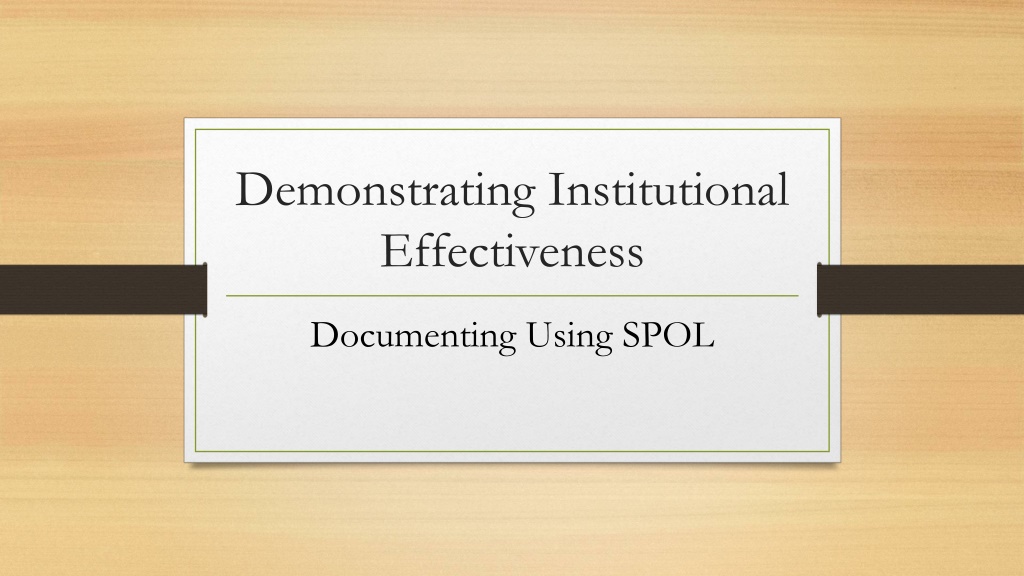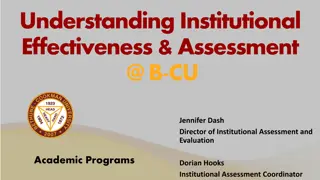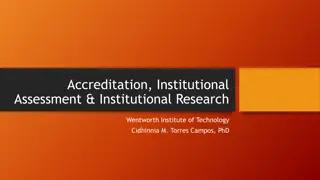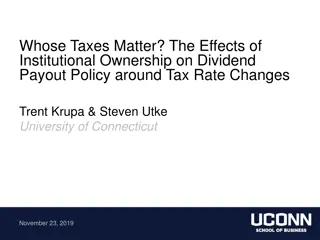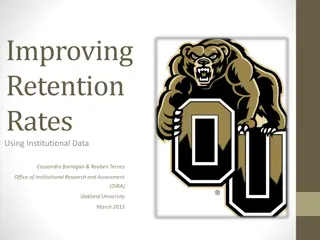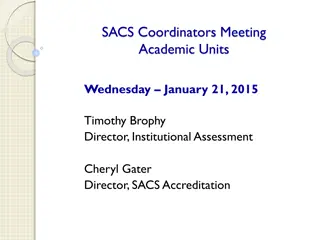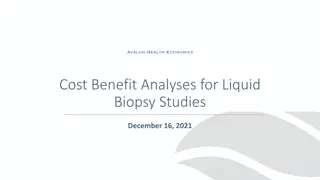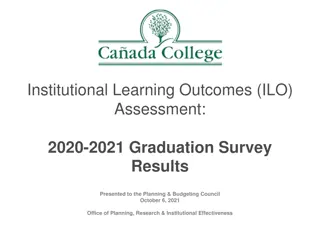Understanding Institutional Effectiveness in Education
Explore the concept of institutional effectiveness, focusing on assessing outcomes and continuous improvement within educational institutions. Learn about SACSCOC Standard 3.3.1, key definitions, and the importance of aligning goals with mission statements for impactful results.
Download Presentation

Please find below an Image/Link to download the presentation.
The content on the website is provided AS IS for your information and personal use only. It may not be sold, licensed, or shared on other websites without obtaining consent from the author. Download presentation by click this link. If you encounter any issues during the download, it is possible that the publisher has removed the file from their server.
E N D
Presentation Transcript
Demonstrating Institutional Effectiveness Documenting Using SPOL
SACSCOC Standard 3.3.1: Institutional Effectiveness The institution identifies expected outcomes, assesses the extent to which it achieves these outcomes, and provides evidence of improvement based on analysis of the results in each of the following areas: Educational programs, to include student learning outcomes Administrative support services Academic and student support services Community/public service within its mission
Institutional Effectiveness Institutional effectiveness is based on an impact-oriented philosophy of continuous organizational improvement.
Some Guiding Definitions Institutional Effectiveness: The degree to which an institution (or department within the institution) is meeting its mission (or having its intended effect or impact) Assessment: A systematic process of gathering and interpreting information to learn how well your unit is performing and using that information to modify your operations in order to improve that performance
Planning vs Institutional Effectiveness Strategic planning ensures that resources and activities are aligned with common goals of the institution. Assessing goal attainment, however, does not necessarily reveal whether the institution or unit is having the impact it wants or needs to have. For that, the institution or unit needs to examine its expected outcomes. Expected outcomes are derived directly from the institution s or unit s mission.
Your Unit Mission Statement The mission of (name of your program or unit) is to (your primary purpose) by providing (your primary functions or activities) to (your stakeholders). These (services, functions, activities, etc.) contribute to the college s mission by (describe how).
Identifying Outcomes An outcome is a result for (or impact on) a customer, stakeholder, or the institution that is a consequence of the work that you do. The outcome itself does not describe the activities that you perform nor the service or product that you provide to get the customer that result.
Identifying Outcomes Outcomes statements will have two critical elements: The intended beneficiary (customers, students, other internal units, the institution as a whole, the community) The gain or benefit they receive from what you do (the impact).
Identifying Outcomes Outcomes need to be measurable. You have to be able to monitor changes for those beneficiaries. Outcomes need to be actionable. You have to have some degree of controllable influence on the outcomes.
Tips for Writing Expected Outcomes Begin the outcome statement with the beneficiary as subject: Customers have Administrators are able to Clients are aware of Students know how to The college gains
Tips for Writing Expected Outcomes By contrast, a goal statement nearly always uses the department as an implied subject and will typically begin with a phrase like: To provide To establish To implement If you mistake a goal statement for an outcome, you will end up assessing your goal attainment rather than the results for the beneficiary.
Example of a Goal Statement: To provide accurate and timely reports to college administrators. Example of an Objective Statement: To produce 4 quarterly reports and 2 annual reports. Example of an Outcome Statement: College administrators will have the financial information they need to make decisions effectively.
Measuring Outcomes 1. Develop Effectiveness Indicators (Measures) An indicator is the particular characteristic, dimension, or element you will be measuring to monitor changes in your outcome attainment. It is a gauge you will use to determine whether you are achieving expected results.
Measuring Outcomes If the outcome is: College administrators will have financial information they need to make decisions effectively, Indicators might include: Timeliness of monthly reports to President s Cabinet Accuracy of information in reports Timely response to requests for ad hoc reports Number of proactive reports generated on topics of interest
Measuring Outcomes 2. Set Targets Targets are the specific values on the indicator (like marks on a yardstick) that you are expecting to reach. 100% of monthly reports are submitted by the 3rd business day of the month At least one proactive report is generated each quarter Fewer than 3% of reports are returned for corrections
Measuring Outcomes 3. Collect Data on your Measures Data collection is easier if you have defined your indicators/measures and targets carefully. If you easily meet your success target, you will want to raise the bar in order to improve your outcome. If you cannot use the data, do not collect it. Certain types of data collection should become a regular activity for the department. The more you can make it routine, the easier it will be to incorporate into your activities.
Measuring Outcomes 4. Compute Results Compare the results to your success target Did you meet your target or not? To what extent were you successful?
Examples of Assessment Methods and Data Sources Surveys of customer satisfaction, perception, awareness Analysis of error rates, processing time Percentage or number of target stakeholders served; requests delivered Compliance with industry standards Interviews or focus groups Year-to-year comparisons Benchmarking with other institutions or best practices Time and/or money saved
Analyzing Outcomes Now that you ve determined the results of your assessment, what do those results mean for your department? Why did you reach or not reach your target? What strategies were successful? Which were not? What will you do differently to improve outcomes? Where do the results show additional attention is needed? What strengths do the results reflect? How can these by further strengthened?
Applying and Using Results of Assessment for Improvement The purpose of assessing outcomes is to provide you with meaningful information that will help you determine where modifications are needed (or wanted) to improve those outcomes and make your department even more effective. Identified problems/issues/gaps represent a need for action to correct or improve performance. Successfully met outcomes represent opportunities for further improvement.
Applying and Using Results of Assessment for Improvement Types of improvement actions or strategies Operational modifying what you do or how you do it (improving a process, adding a program/service, etc.) Organizational modifying your structure or work assignments Strategic modifying your mission, functional responsibilities or outcomes Assessment related modifying your indicators/measures, targets, or methods of data collection
